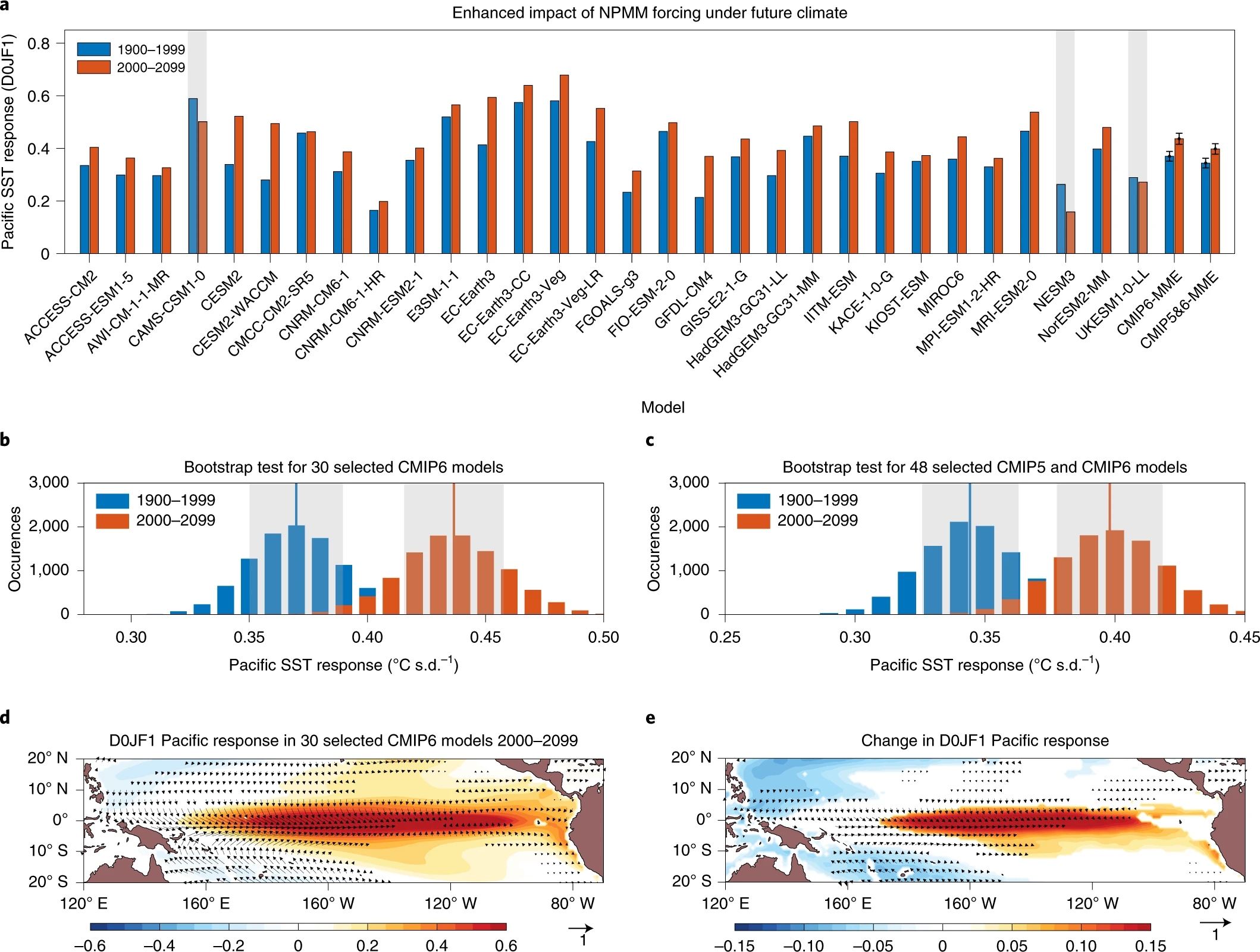Enhanced North Pacific impact on El Niño/Southern Oscillation under greenhouse warming
Fan Jia, Wenju Cai, Bolan Gan, Lixin Wu & Emanuele Di Lorenzo
Published in Nature Climate Change, SEP 2021
A majority of El Niño/Southern Oscillation (ENSO) events are preceded by the North Pacific Meridional Mode (NPMM), a dominant coupled ocean–atmospheric mode of variability. How the precursory NPMM forcing on ENSO responds to greenhouse warming remains unknown. Here, using climate model ensembles under high-emissions warming scenarios, we find an enhanced future impact on ENSO by the NPMM. This is manifested by increased sensitivity of boreal-winter equatorial Pacific winds and sea surface temperature (SST) anomalies to the NPMM three seasons before. The enhanced NPMM impact translates into an increased frequency of NPMM that leads to an extreme El Niño or La Niña. Under greenhouse warming, higher background SSTs cause a nonlinear evaporation–SST relationship to more effectively induce surface wind anomalies in the equatorial western Pacific, conducive to ENSO development. Thus, NPMM contributes to an increased frequency of future extreme ENSO events and becomes a more influential precursor for their predictability.

Fig.2 a, Comparison of the D0JF1 equatorial Pacific SST response under 100-year present-day (1900–1999; blue bars) and future (2000–2099; orange bars) climate in the 30 selected CMIP6 models. The multimodel mean and corresponding error bars for the CMIP6 models (labelled CMIP6-MME) and for the 48 selected CMIP5 and CMIP6 models combined (labelled CMIP5&6-MME) are also shown. Error bars are calculated as 1.0 s.d. of 10,000 inter-realizations of a bootstrap method (see Bootstrap test in Methods). Three models that simulate a decreased connection are greyed out. b,c, Histograms of 10,000 realizations of a bootstrap method for the Pacific SST response in the CMIP6 models (b) and in the CMIP5 and CMIP6 models combined (c). Blue and orange vertical lines indicate the mean values of 10,000 inter-realizations for the present-day and future periods, respectively. The grey shaded regions indicate the respective 1.0 s.d. of the 10,000 inter-realizations. d, Multimodel-mean spatial pattern of the D0JF1 Pacific response to the NPMM under future climate of the 30 selected CMIP6 models, obtained as for the present-day climate shown in Fig. 1c. e, Multimodel mean change in the D0JF1 Pacific response pattern between the future and present-day periods using the 30 selected CMIP6 models. Only the mean that exceeds 1.0 s.d. in d, or the change that is statistically significant above the 95% confidence level as determined by a two-sided Student’s t test in e, is shown. Colour bars in d,e represent regression coefficients (°C s.d.–1).
Jia, F., Cai, W., Gan, B. et al. Enhanced North Pacific impact on El Niño/Southern Oscillation under greenhouse warming. Nat. Clim. Chang. (2021). https://doi.org/10.1038/s41558-021-01139-x